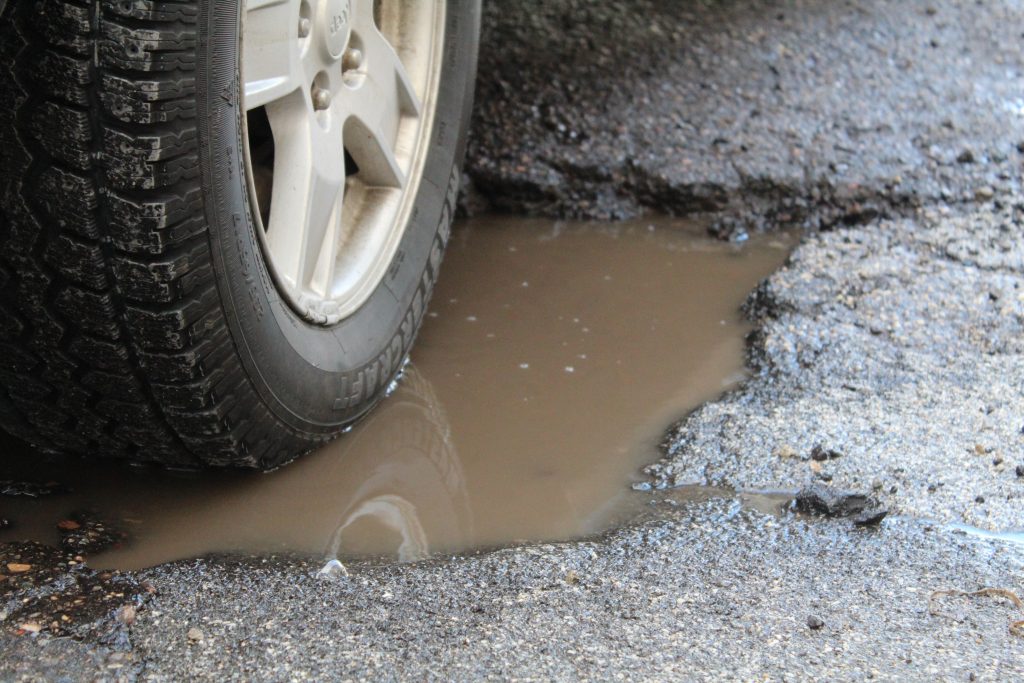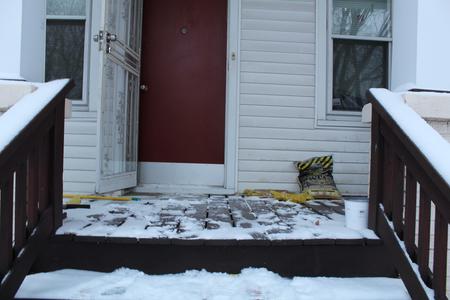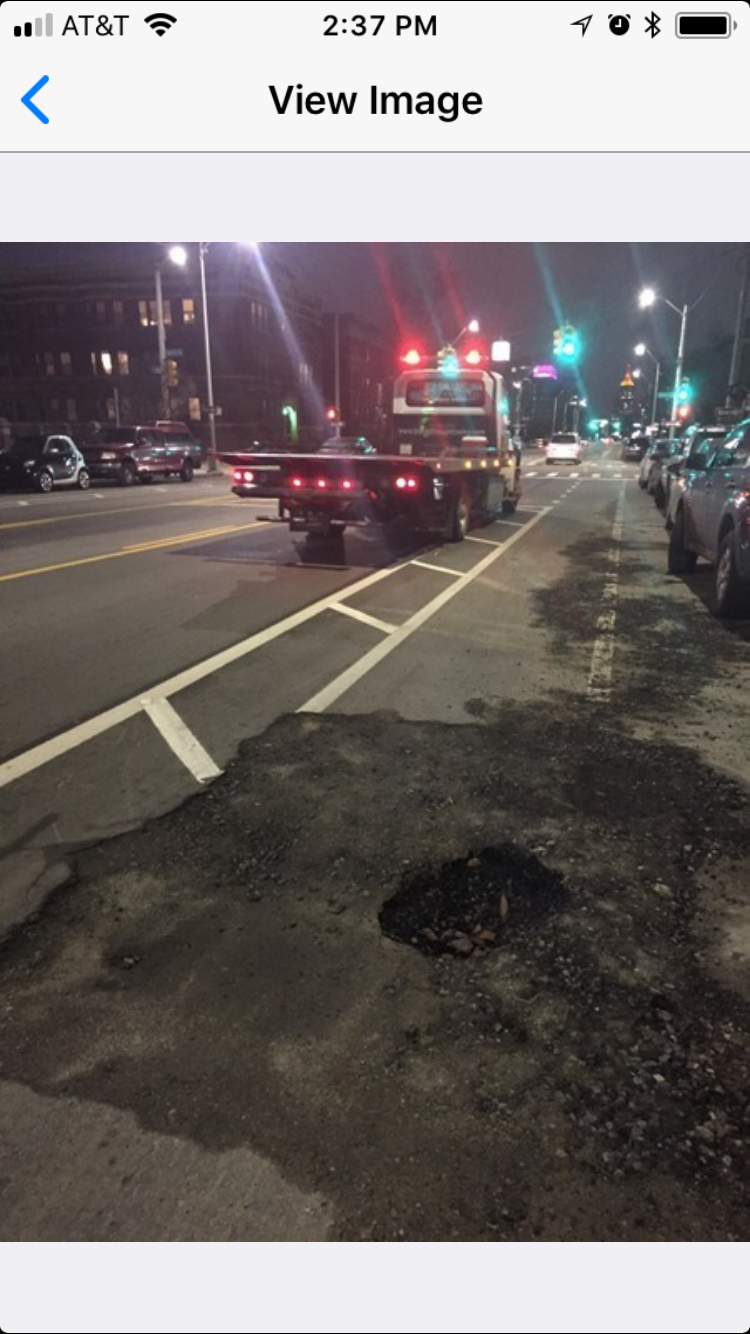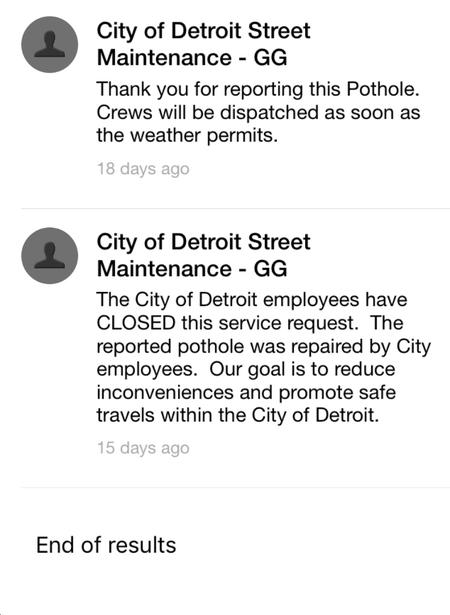Got Pothole Problems?
How a bag of asphalt, an app, and a fancy mixture might help.

Temperatures have been fluctuating wildly this winter. One day it’s 4 degrees, two days later it’s 40. That’s perfect weather for potholes to form. But fear not drivers, this doesn’t necessarily mean your tires are doomed. Here’s a look at ways residents, cities and engineers are combating those pesky road craters.

The DIY Method
In Hamtramck, a bag of filler called “cold patch” is on a porch. It reminds Hamtramck resident Jonathan Weier of when he and other residents took pothole matters into their own hands.
“I still haven’t even moved the bag of cold patch from the summer we did that.” said Weier.
In 2015, he was sitting around drinking with some friends when they came up with an idea.
“We kind of posed the question of what would happen if we attempted to attack potholes,” said Weier. “After we woke up the next day we were kind of inspired and we looked into it.”
They discovered that if they bought gooey, gravelly cold patch, poured it into holes and patted it down, they could repair potholes themselves. They made a GoFundMe which raised nearly $5,000 and began working with their neighbors to patch up roads that city officials said were not scheduled to be fixed. The group called themselves Hamtramck Guerilla Road Crew.
“We kind of posed the question of what would happen if we attempted to attack potholes,” said Weier. “After we woke up the next day we were kind of inspired and we looked into it.”
Word of their efforts blew up like a tire hitting a pothole.
“I anticipated someone buying me a beer at the end of the summer being like, ‘Hey, that was a good idea’ … ‘Glad we filled those potholes.’ Instead, it was just total madness,” Weier said.
Local and national media flocked to the story and the project. When the next warm season came along, Weier and his friends decided not to take up the cause again. It turns out, they didn’t have to.
“We lucked out, and the city seemed to take note with all the news,” said Weier. “Early next spring there were already spray patch trucks out there doing work, which was significantly sooner than the years before.”
Map of Potholes Reported Via the “Improve Detroit” App November 2017 – January 2018
SOURCE: City of Detroit Improve Detroit Issues data




Potholes in Detroit
Cornelius Palm, the assistant manager for the Street Maintenance Division at Detroit Department of Public Works, knows the city’s roads.
“I don’t know that Detroit’s roads are any worse than anybody else’s,” said Palm.
The freeze-thaw cycle is what creates these road craters. Water seeps into the pavement then when it freezes, the water expands and carves out holes.
By mid-January, Palm estimated he had a “few hundred” potholes on his repair list. His team surveys the roads to find new potholes. Drivers also report potholes over the phone or by using the city’s Improve Detroit smart phone and web app, a tool for citizens to report problems.
“Well, actually, it’s an app that pretty much anyone that has a smartphone can utilize,” said Palm. “Download it onto your phone, say you run across your pothole, put your information in and it automatically notifies us.”
Some 3,200 pothole issues were submitted to Improve Detroit in 2017. Of those, all but 14 are now marked as “closed.” On average, the process to close them took three days.
Sometimes potholes in Detroit are reported on roads maintained by the county or the state. When that happens, Palm said they’re passed along to the responsible parties. When WDET reported a pothole on a city road via the app we received the following responses:
“Thank you for reporting this issues to the City of Detroit. Unfortunately, the reported pothole is located within Wayne County’s Jurisdiction. Please contract 1-888-ROAD CREW (888-762-3273) for any matters on County Right-of-Way.” And, in a separate comment: “This issue was recategorized from Potholes to Other within City jurisdiction.”
Whether the road is maintained by the State of Michigan, the City of Detroit, or Wayne, Oakland or Macomb Counties, drivers can actually get reimbursed for damage to cars from pothole.

Trinity Street Potholes
Detroiter Karen Williams said there are several potholes in her Northwest neighborhood. But, she said, the one on Trinity Street is about as bad as it gets.
“I think they even have one of those big ol’ metal things that cover the hole,” said Williams. “Then you have to drive down on the wrong side of the street on Trinity, because the right side of the street you can’t get down.”
Williams stopped using the road because it’s so bad. But one afternoon when she turned onto it, she was shocked by what she found.
“Oh they redid it! That’s a good thing,” she said as she saw it.
It’s the Stuff That Roads Are Made Of
The best defense against potholes is putting down new pavement. Detroit officials say nearly 100 miles of road, like this stretch of Trinity, were resurfaced last year.
But even when roads are repaved, it makes a difference what materials are used.
Dr. Sherif El-Tawil, a professor in the Department of Civil and Environmental Engineering at the University of Michigan, says there are two classes of pavement: rigid and flexible.
“The flexible pavements are what you and I drive most of our time on. They are made of asphalt concrete. Asphalt is where you would run into most of your potholes,” said El-Tawil.
“The other class of pavements, the rigid ones, are made of reinforced concrete. These are concrete slabs like the foundation of a house, for example, is a concrete slab. And these slabs are usually poured in panels side-by-side. They represent a roadway, they can be a pavement as well.”
Companies have developed a special type of this rigid concrete called ultra high performance concrete. It’s fancy stuff. And it’s expensive.
At the Michigan Department of Transportation’s request, El-Tawil’s lab developed a formula for a generic version of this concrete. It’s made of tiny ingredients like sand and steel fibers that can be densely packed together in a way that creates strength.
“The strength of this material is at least six to seven times the strength of regular concrete. But to me the exciting thing is really the durability, it’s ability to take many freeze-thaw cycles before it deteriorates,” said El-Tawil.
“The strength of this material is at least six to seven times the strength of regular concrete. But to me the exciting thing is really the durability, it’s ability to take many freeze-thaw cycles before it deteriorates,” said El-Tawil.
Asphalt tested in El-Tawil’s labs deteriorated after 28 freeze-thaw cycles. The ultra high performance concrete they created could withstand up to 90 freeze-thaw cycles. So why isn’t this material used on roads everywhere?
El-Tawil says part of it is the price – the materials in the generic formula they developed still cost more than asphalt. And also, rigid concrete is louder – vehicles traveling on it make a kind of whirring noise, which isn’t ideal for drivers or nearby residents. Nonetheless El-Tawil says MDOT used the material on a bridge in St. Clair County.
“I know that this is a hot material right now, so many states are starting to figure out the benefits of ultra high performance concrete and are following up on the heels of Michigan Department of Transportation,” he said. “I think down the line there will be numerous structures in the U.S. that use this material.”
